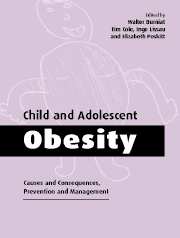Book contents
- Frontmatter
- Contents
- List of contributors
- Foreword
- Preface
- Part I Causes
- 1 Measurement and definition
- 2 Epidemiology
- 3 Molecular and biological factors with emphasis on adipose tissue development
- 4 Nutrition
- 5 Physical Activity
- 6 Psychosocial factors
- Part II Consequences
- Part III Prevention and management
- Index
5 - Physical Activity
Published online by Cambridge University Press: 02 November 2009
- Frontmatter
- Contents
- List of contributors
- Foreword
- Preface
- Part I Causes
- 1 Measurement and definition
- 2 Epidemiology
- 3 Molecular and biological factors with emphasis on adipose tissue development
- 4 Nutrition
- 5 Physical Activity
- 6 Psychosocial factors
- Part II Consequences
- Part III Prevention and management
- Index
Summary
Introduction
Normal growth in children involves large fluctuations in both daily energy intake and expenditure and, hence, acute daily fluctuations in energy balance. This indicates the complex interaction of different control mechanisms that must coexist to maintain adequate body weight and body composition during growth and maturation (Rosenbaum & Leibel, 1998). The exact mechanisms involved in body weight regulation remain largely unknown.
In many adults, stability of body weight and body composition over long periods of time indicates that energy and macronutrient intakes and expenditures are balanced. By contrast, in growing children, energy and substrate intakes must be chronically greater than energy expenditures and total substrate oxidation, though not necessarily on a daily basis, in order to accommodate normal growth. Thus, obesity in children can be viewed as ‘overgrowth’ of the adipose tissue normally synthesized to achieve normal body composition.
This chapter will review current knowledge relating to physical activity and inactivity in the development of obesity during childhood.
Energy expenditure assessment
A number of methods have been developed to assess total energy expenditure (TEE) in free-living conditions (Schutz & Deurenberg, 1996). The most recent method is the doubly labelled water technique based on the utilization of stable isotopes using heavy water (deuterium and oxygen 18). Detailed explanation of the method is given elsewhere (Schoeller et al., 1986).
- Type
- Chapter
- Information
- Child and Adolescent ObesityCauses and Consequences, Prevention and Management, pp. 93 - 108Publisher: Cambridge University PressPrint publication year: 2002
- 2
- Cited by



